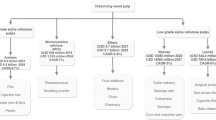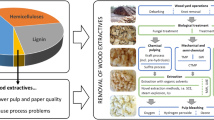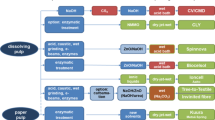Abstract
The demand for paper and pulp-derived products to fulfill consumer needs is increasing considerably globally. This work provides a critical overview of the various traditional pulping methods and describes the recent improvements in pulping processes. A comparison of different pulping techniques has shown that the mechanical pulping process produces high pulp yields per unit volume of wood of poor quality (low strength, bonding, fiber morphology, etc.) as compared to chemical pulping methods. The use of semi-chemical pulping is reported as an effective way of overcoming the disadvantages of the mechanical pulping process. Recent modifications of the pulping processes that have happened in the last decade have been discussed and shown to be driven by the desire to save energy and reduce chemical requirements while maximizing pulp yields and quality. With the emergence of bio-based nanotechnology, post-pretreatment of Kraft and sulfite pulps for making nanocellulose and lignin-containing nanocellulose with improved fiber characteristics of fiber size, crystallinity, chemical composition, and fiber surface functionality has been discussed. Furthermore, challenges and prospects of the improvements in pulping processes are highlighted.

Similar content being viewed by others
References
Laftah WA, Wan Abdul Rahman WA (2016) Pulping process and the potential of using non-wood pineapple leaves fiber for pulp and paper production: a review. J Nat Fibers 13:85–102. https://doi.org/10.1080/15440478.2014.984060
Kuusisto I (2004) Trends and developments in the Chinese pulp and paper industry. Presentation prepared for the International forum on investment and finance in China’s forestry sector, Beijing
Kamoga OLM, Byaruhanga JK, Kirabira JB (2013) A review on pulp manufacture from non wood plant materials. Int J Chem Eng Appl 4:144–148. https://doi.org/10.7763/IJCEA.2013.V4.281
Rodríguez A, Moral A, Serrano L, Labidi J, Jiménez L (2008) Rice straw pulp obtained by using various methods. Bioresour Technol 99:2881–2886. https://doi.org/10.1016/j.biortech.2007.06.003
Jiménez L, Rodríguez A, Pérez A, Moral A, Serrano L (2008) Alternative raw materials and pulping process using clean technologies. Ind Crop Prod 28:11–16. https://doi.org/10.1016/j.indcrop.2007.12.005
FAO (2009) State of the world’s forests 2009. FAO, Rome
Mandeep, Kumar Gupta G, Shukla P (2020) Insights into the resources generation from pulp and paper industry wastes: challenges, perspectives and innovations. Bioresour Technol 297:122496
Obidzinski K, Dermawan A (2012) Pulp industry and environment in Indonesia: is there sustainable future? Reg Environ Chang 12:961–966. https://doi.org/10.1007/s10113-012-0353-y
Wang Q, Jahan MS, Liu S, Miao Q, Ni Y (2014) Lignin removal enhancement from prehydrolysis liquor of kraft-based dissolving pulp production by laccase-induced polymerization. Bioresour Technol 164:380–385. https://doi.org/10.1016/j.biortech.2014.05.005
Bajpai P (2011) Biotechnology for pulp and paper processing. Springer US, New York. https://doi.org/10.1007/978-1-4614-1409-4
Das TK, Houtman C (2004) Evaluating chemical-, mechanical-, and bio-pulping processes and their sustainability characterization using life-cycle assessment. Environ Prog 23:347–357. https://doi.org/10.1002/ep.10054
Martín-Sampedro R, Fillat Ú, Ibarra D, Eugenio ME (2015) Towards the improvement of Eucalyptus globulus chemical and mechanical pulping using endophytic fungi. Int Biodeterior Biodegrad 105:120–126. https://doi.org/10.1016/j.ibiod.2015.08.023
Xu X, Liu F, Jiang L, Zhu JY, Haagenson D, Wiesenborn DP (2013) Cellulose nanocrystals vs. cellulose nanofibrils: a comparative study on their microstructures and effects as polymer reinforcing agents. ACS Appl Mater Interfaces 5:2999–3009. https://doi.org/10.1021/am302624t
Rojo E, Peresin MS, Sampson WW, Hoeger IC, Vartiainen J, Laine J, Rojas OJ (2015) Comprehensive elucidation of the effect of residual lignin on the physical, barrier, mechanical and surface properties of nanocellulose films. Green Chem 17:1853–1866. https://doi.org/10.1039/c4gc02398f
Verma SR, Dwivedi UN (2014) Lignin genetic engineering for improvement of wood quality: applications in paper and textile industries, fodder and bioenergy production. South African J Bot 91:107–125. https://doi.org/10.1016/j.sajb.2014.01.002
Jia M, Sun M, Li X, Xu X, Wang Y, Shi L, Hu H (2018) A new era of straw-based pulping? Evidence from a carbon metabolism perspective. J Clean Prod 193:327–337. https://doi.org/10.1016/j.jclepro.2018.04.227
Biermann CJ (1996) Handbook of pulping and papermaking, 2nd ed. Elsevier Inc.
Kocurek MJ, Frederick S, Joint Textbook Committee of the Paper Industry (1983) Pulp & Paper Manufacture, 3rd ed. TAPPI
Gullichsen J, Fogelholm CJ, Yhdistys (1999) Chemical pulping, volume 2. Fapet Oy
Stephenson NJ (1950) Pulp and paper manufacture volume 1 - preparation & treatment of wood pulp. Pulp pap pulp mill bleach
Grant I (1958) Cellulose pulp & allied products, 3rd ed. Thomas Reed & Company limited
Passas R (2012) Natural fibres for paper and packaging. In: Handbook of Natural Fibres. Elsevier, pp. 367–400
Koch G (2008) Raw material for pulp. In: Herbert S (ed) Handbook of pulp. Wiley-VCH Verlag GmbH, Weinheim, pp 21–68
Iglesias MC, Gomez-Maldonado D, Via BK et al (2020) Pulping processes and their effects on cellulose fibers and nanofibrillated cellulose properties: a review. For Prod J 70:10–21. https://doi.org/10.13073/FPJ-D-19-00038
Malkov S, Tikka P, Gustafson R et al (2003) Towards complete impregnation of wood chips with aqueous solutions. Part 5: improving uniformity of kraft displacement batch pulping. Pap ja Puu/Paper Timber 85:215–220
Stelte W, Sanadi AR (2009) Preparation and characterization of cellulose nanofibers from two commercial hardwood and softwood pulps. Ind Eng Chem Res 48:11211–11219. https://doi.org/10.1021/ie9011672
Rubin EM (2008) Genomics of cellulosic biofuels. Nature 454:841–845. https://doi.org/10.1038/nature07190
Pu Y, Zhang D, Singh PM, Ragauskas AJ (2008) The new forestry biofuels sector. Biofuels Bioprod Biorefin 2:58–73
Mboowa D, Khatri V, Saddler JN (2020) The use of fluorescent protein-tagged carbohydrate-binding modules to evaluate the influence of drying on cellulose accessibility and enzymatic hydrolysis. RSC Adv 10:27152–27160. https://doi.org/10.1039/d0ra05333c
Hallac BB, Sannigrahi P, Pu Y, Ray M, Murphy RJ, Ragauskas AJ (2010) Effect of ethanol organosolv pretreatment on enzymatic hydrolysis of Buddleja davidii stem biomass. Ind Eng Chem Res 49:1467–1472. https://doi.org/10.1021/ie900683q
Shallom D, Shoham Y (2003) Microbial hemicellulases. Curr Opin Microbiol 6:219–228. https://doi.org/10.1016/S1369-5274(03)00056-0
Argyropoulos DS (2001) Wood and cellulosic chemistry. Second Edition, Revised and Expanded Edited by David N.-S. Hon (Clemson University) and Nubuo Shiraishi (Kyoto University). Marcel Dekker: New York and Basel. 2001. vii + 914 pp. $250.00. ISBN 0-8247-0024-4. J Am Chem Soc 123:8880–8881. https://doi.org/10.1021/ja015237p
Kallioinen A (2014) Development of pretreatment technology and enzymatic hydrolysis for biorefineries
Buranov AU, Mazza G (2008) Lignin in straw of herbaceous crops. Ind Crop Prod 28:237–259
Dimmel DR, MacKay JJ, Courchene CE et al (2002) Pulping and bleaching of partially CAD-deficient wood. J Wood Chem Technol 22:235–248. https://doi.org/10.1081/WCT-120016260
Hintz HL (2001) Paper: pulping and bleaching. In: Encyclopedia of Materials: Science and Technology. Elsevier, pp 6707–6711
Sixta H (2006) Chemical pulping. Handbook of pulp. Wiley-VCH Verlag GMbH & Co, KGaA, Weinheim
Smook GA (1989) Handbook for pulp and paper technologists
Mooney CA, Mansfield SD, Touhy MG, Saddler JN (1998) The effect of initial pore volume and lignin content on the enzymatic hydrolysis of softwoods. Bioresour Technol 64:113–119. https://doi.org/10.1016/S0960-8524(97)00181-8
Fengel D, Wegener G (1989) Wood: chemistry, ultrastructure, reactions
Lei X, Zhao Y, Li K, Pelletier A (2012) Improved surface properties of CTMP fibers with enzymatic pretreatment of wood chips prior to refining. Cellulose 19:2205–2215. https://doi.org/10.1007/s10570-012-9792-3
Han X, Bi R, Oguzlu H, Takada M, Jiang J, Jiang F, Bao J, Saddler JN (2020) Potential to produce sugars and lignin-containing cellulose nanofibrils from enzymatically hydrolyzed chemi-thermomechanical pulps. ACS Sustain Chem Eng 8:14955–14963. https://doi.org/10.1021/acssuschemeng.0c05183
Gupta GK, Kapoor RK, Shukla P (2020) Advanced techniques for enzymatic and chemical bleaching for pulp and paper industries. In: Microbial Enzymes and Biotechniques. Springer Singapore, pp. 43–56
Wallmo H, Theliander H, Jönsson AS, Wallberg O, Lindgren K (2009) The influence of hemicelluloses during the precipitation of lignin in kraft black liquor. Nord Pulp Pap Res J 24:165–171. https://doi.org/10.3183/NPPRJ-2009-24-02-p165-171
Marinova M, Mateos-Espejel E, Paris J (2010) From kraft mill to forest biorefinery: an energy and water perspective. II. Case study. In: Cellulose Chemistry and Technology. pp 21–26
Mendes CVT, Carvalho MGVS, Baptista CMSG, Rocha JMS, Soares BIG, Sousa GDA (2009) Valorisation of hardwood hemicelluloses in the kraft pulping process by using an integrated biorefinery concept. Food Bioprod Process 87:197–207. https://doi.org/10.1016/j.fbp.2009.06.004
Tran H, Vakkilainnen EK (2012) The Kraft chemical recovery process. TAPPI Kraft Recover Course 1–8. 10.1.1.452.6675
Mboowa D, Quereshi S, Bhattacharjee C, Tonny K, Dutta S (2017) Qualitative determination of energy potential and methane generation from municipal solid waste (MSW) in Dhanbad (India). Energy 123:386–391. https://doi.org/10.1016/j.energy.2017.02.009
Mboowa D, Kabenge I, Banadda N, Kiggundu N (2017) Energy potential of municipal solid waste in Kampala, a case study of Kiteezi Landfill Site. Afr J Environ Waste Manag 4:190–194
Drake M, Noble B, Nicholas K, Isa K, Allan JK (2015) Estimation of methane generation based on anaerobic digestion and mass balance at Kiteezi Landfill, Kampala, Uganda. Afr J Environ Sci Technol 9:741–746. https://doi.org/10.5897/ajest2015.1922
Chylenski P, Forsberg Z, Ståhlberg J, Várnai A, Lersch M, Bengtsson O, Sæbø S, Horn SJ, Eijsink VGH (2017) Development of minimal enzyme cocktails for hydrolysis of sulfite-pulped lignocellulosic biomass. J Biotechnol 246:16–23. https://doi.org/10.1016/J.JBIOTEC.2017.02.009
Kilulya KF, Msagati TAM, Mamba BB, Ngila JC, Bush T (2012) Study of the fate of lipophilic wood extractives during acid sulphite pulping process by ultrasonic solid-liquid extraction and gas chromatography mass spectrometry. J Wood Chem Technol 32:253–267. https://doi.org/10.1080/02773813.2012.659319
Viikari L, Suurnäkki A, Grönqvist S, et al (2009) Forest products: biotechnology in pulp and paper processing. In: Encyclopedia of Microbiology. Elsevier Inc., pp. 80–94
Kordsachia O, RoBkopf S, Patt R (2004) Production oF spruce dissolving pulp with the prehydrolysis-alkaline sulfite process (PH-ASA). Lenzinger Berichte 83:24–34
Mboowa D, Chandra RP, Hu J, Saddler JN (2020) Substrate characteristics that influence the filter paper assay’s ability to predict the hydrolytic potential of cellulase mixtures. ACS Sustain Chem Eng 8:10521–10528. https://doi.org/10.1021/acssuschemeng.0c02883
Mboowa D (2019) How can we better predict the hydrolytic performance of commercial cellulase enzyme preparations on a range of biomass substrates? MSc Thesis submitted to University of British Columbia
Fink HP, Weigel P, Ganster J, Rihm R, Puls J, Sixta H, Parajo JC (2004) Evaluation of new organosolv dissolving pulps. Part II: structure and NMMO processability of the pulps. Cellulose 11:85–98. https://doi.org/10.1023/B:CELL.0000014779.93590.a0
Vila C, Santos V, Parajó JC (2004) Dissolving pulp from TCF bleached Acetosolv beech pulp. J Chem Technol Biotechnol 79:1098–1104. https://doi.org/10.1002/jctb.1090
Gonzalo A, Bimbela F, Sánchez JL, Labidi J, Marín F, Arauzo J (2017) Evaluation of different agricultural residues as raw materials for pulp and paper production using a semichemical process. J Clean Prod 156:184–193. https://doi.org/10.1016/j.jclepro.2017.04.036
Teixeira DE (2012) Recycled old corrugated container fibers for wood-fiber cement sheets. ISRN For 2012:1–8. https://doi.org/10.5402/2012/923413
Masrol SR, Ibrahim MHI, Adnan S, et al (2016) Characteristics of linerboard and corrugated medium paper made from durian rinds chemi-mechanical pulp. In: MATEC Web of Conferences
Fatehi P, Gao W, Sun Y, Dashtban M (2016) Acidification of prehydrolysis liquor and spent liquor of neutral sulfite semichemical pulping process. Bioresour Technol 218:518–525. https://doi.org/10.1016/j.biortech.2016.06.138
Tarasov D, Leitch M, Fatehi P (2017) Thermal properties of lignocellulosic precipitates from neutral sulfite semichemical pulping process. Fuel Process Technol 158:146–153. https://doi.org/10.1016/j.fuproc.2016.12.017
Cave G, Fatehi P (2015) Separation of lignosulfonate from spent liquor of neutral sulphite semichemical pulping process via surfactant treatment. Sep Purif Technol 151:39–46. https://doi.org/10.1016/j.seppur.2015.07.017
Wedin H (2012) Aspects of extended impregnation kraft cooking for high-yield pulping of hardwood. Thesis Submitted to KTH Royal Institute of Technology for Partial Fulfillment of the Degree of Philosophy in Chemical Science and Engineering
Daud WRW, Wahid KA, Law KN (2013) Cold soda pulping of oil palm empty fruit bunch (OPEFB). BioResources 8:6151–6160. https://doi.org/10.15376/biores.8.4.6151-6160
Mandeep, Gupta GK, Liu H, Shukla P (2019) Pulp and paper industry–based pollutants, their health hazards and environmental risks. Curr Opin Environ Sci Health 12:48–56
Singh G, Kaur S, Khatri M, Arya SK (2019) Biobleaching for pulp and paper industry in India: emerging enzyme technology. Biocatal Agric Biotechnol 17:558–565
Fonseca MI, Fariña JI, Castrillo ML, Rodríguez MD, Nuñez CE, Villalba LL, Zapata PD (2014) Biopulping of wood chips with Phlebia brevispora BAFC 633 reduces lignin content and improves pulp quality. Int Biodeterior Biodegrad 90:29–35. https://doi.org/10.1016/j.ibiod.2013.11.018
Poojary H, Hoskeri A, Kaur A, Mugeraya G (2012) Comparative production of ligninolytic enzymes from novel isolates of Basidiomycetes and their potential to degrade textile dyes. Nat Sci 10:90–96
Behrendt CJ, Blanchette RA, Akhtar M et al (2000) Biomechanical pulping with Phlebiopsis gigantea reduced energy consumption and increased paper strength. TAPPI J 83:65–70
Eugenio ME, Santos M, Carbajo JM et al (2010) Kraft pulp biobleaching using an extracellular enzymatic fluid produced by Pycnoporus sanguineus. Bioresour Technol 101:1866–1870. https://doi.org/10.1016/j.biortech.2009.09.084
Saxena A, Singh Chauhan P (2017) Role of various enzymes for deinking paper: a review. Crit Rev Biotechnol 37:598–612
Nagar S, Jain RK, Thakur VV, Gupta VK (2013) Biobleaching application of cellulase poor and alkali stable xylanase from Bacillus pumilus SV-85S. 3 Biotech 3:277–285. https://doi.org/10.1007/s13205-012-0096-y
Valls C, Roncero MB (2009) Using both xylanase and laccase enzymes for pulp bleaching. Bioresour Technol 100:2032–2039. https://doi.org/10.1016/j.biortech.2008.10.009
Bajpai P (2012) Enzymatic pre-bleaching. In: Environmentally Benign Approaches for Pulp Bleaching. pp. 189–223
Sharma A, Thakur VV, Shrivastava A, Jain RK, Mathur RM, Gupta R, Kuhad RC (2014) Xylanase and laccase based enzymatic kraft pulp bleaching reduces adsorbable organic halogen (AOX) in bleach effluents: a pilot scale study. Bioresour Technol 169:96–102. https://doi.org/10.1016/j.biortech.2014.06.066
Huysveld S, De Meester S, Van Linden V et al (2015) Cumulative Overall Resource Efficiency Assessment (COREA) for comparing bio-based products with their fossil-derived counterparts. Resour Conserv Recycl 102:113–127. https://doi.org/10.1016/j.resconrec.2015.06.007
Bos HL, Broeze J (2020) Circular bio-based production systems in the context of current biomass and fossil demand. Biofuels Bioprod Biorefin 14:187–197. https://doi.org/10.1002/bbb.2080
Fiorentino G, Zucaro A, Ulgiati S (2019) Towards an energy efficient chemistry. Switching from fossil to bio-based products in a life cycle perspective. Energy 170:720–729. https://doi.org/10.1016/j.energy.2018.12.206
Manda BMK, Blok K, Patel MK (2012) Innovations in papermaking: an LCA of printing and writing paper from conventional and high yield pulp. Sci Total Environ 439:307–320. https://doi.org/10.1016/j.scitotenv.2012.09.022
Azeez MA (2018) Pulping of non-woody biomass. In: Pulp and Paper Processing. InTech
Khristova P, Kordsachia O, Patt R, Dafaalla S (2006) Alkaline pulping of some eucalypts from Sudan. Bioresour Technol 97:535–544. https://doi.org/10.1016/j.biortech.2005.04.006
Chen Z, Zhang H, He Z et al (2019) Bamboo as an emerging resource for worldwide pulping and papermaking. BioResources 14:3–5. https://doi.org/10.15376/biores.14.1.3-5
Erik D, Jochen B (2013) Biomass as energy source. CRC Press
Inalbon MC, Mussati MC, Zanuttini MA (2009) Experimental and theoretical analysis of the alkali impregnation of eucalyptus wood. Ind Eng Chem Res 48:4791–4795. https://doi.org/10.1021/ie801685a
Asim M (2012) Effects of prehydrolysis prior to kraft cooking on Swedish Spruce Wood. Thesis submitted for partial fulfillment of Master of Science in Chemical Engineering at Karlstads University
Jiang J, Carrillo-Enríquez NC, Oguzlu H, Han X, Bi R, Song M, Saddler JN, Sun RC, Jiang F (2020) High production yield and more thermally stable lignin-containing cellulose nanocrystals isolated using a ternary acidic deep eutectic solvent. ACS Sustain Chem Eng 8:7182–7191. https://doi.org/10.1021/acssuschemeng.0c01724
Rezvani Ghomi E, Khalili S, Nouri Khorasani S, Esmaeely Neisiany R, Ramakrishna S (2019) Wound dressings: current advances and future directions. J Appl Polym Sci 136:47738. https://doi.org/10.1002/app.47738
Kedzior SA, Gabriel VA, Dubé MA, Cranston ED (2020) Nanocellulose in emulsions and heterogeneous water-based polymer systems: a review. Adv Mater 2002404. https://doi.org/10.1002/adma.202002404
Pakdel AS, Niinivaara E, Cranston ED, Berry RM, Dubé MA (2020) Cellulose nanocrystal (CNC)–latex nanocomposites: effect of CNC hydrophilicity and charge on rheological, mechanical, and adhesive properties. Macromol Rapid Commun. https://doi.org/10.1002/marc.202000448
Lv S, Zhou H, Bai L et al (2020) Development of food-grade Pickering emulsions stabilized by a mixture of cellulose nanofibrils and nanochitin. Food Hydrocoll. https://doi.org/10.1016/j.foodhyd.2020.106451
Chanoca A, de Vries L, Boerjan W (2019) Lignin engineering in forest trees. Front Plant Sci 10:912
Rastogi S, Dwivedi UN (2006) Down-regulation of lignin biosynthesis in transgenic Leucaena leucocephala harboring O-methyltransferase gene. Biotechnol Prog 22:609–616. https://doi.org/10.1021/bp050206+
Baucher M, Halpin C, Petit-Conil M, Boerjan W (2003) Critical reviews in biochemistry and molecular biology lignin: genetic engineering and impact on pulping lignin: genetic engineering and impact on pulping. Crit Rev Biochem Mol Biol 384:305–350. https://doi.org/10.1080/10409230390242443
Grabber JH, Hatfield RD, Lu F, Ralph J (2008) Coniferyl ferulate incorporation into lignin enhances the alkaline delignification and enzymatic degradation of cell walls. Biomacromolecules 9:2510–2516. https://doi.org/10.1021/bm800528f
Golmaei M, Kinnarinen T, Jernström E, Häkkinen A (2018) Efficient separation of hazardous trace metals and improvement of the filtration properties of green liquor dregs by a hydrocyclone. J Clean Prod 183:162–171. https://doi.org/10.1016/j.jclepro.2018.02.123
Koumba-yoya G, Stevanovic T (2017) Transformation of sugar maple bark through catalytic organosolv pulping. Catalysts 7:294. https://doi.org/10.3390/catal7100294
Makitalo M, Lu J, Stahre N, et al (2012) Assessment of the effect of aging on green liquor dregs cover for tailings deposits: field investigation. Proc 8th WASCON 1–5
Hisano H, Nandakumar R, Wang ZY (2009) Genetic modification of lignin biosynthesis for improved biofuel production. In Vitro Cell Dev Biol Plant 45:306–313
Bhattarai K, Rajasekar S, Dixon RA, Monteros MJ (2018) Agronomic performance and lignin content of HCT down-regulated alfalfa (Medicago sativa L.). Bioenergy Res 11:505–515. https://doi.org/10.1007/s12155-018-9911-6
Funding
Canadian Queen Elizabeth II Diamond Jubilee Scholarship.
Author information
Authors and Affiliations
Contributions
Drake Mboowa designed and wrote this review article.
Corresponding author
Ethics declarations
Conflict of interest
The author declares that there are no conflicts of interest.
Additional information
Publisher’s note
Springer Nature remains neutral with regard to jurisdictional claims in published maps and institutional affiliations.
Rights and permissions
About this article
Cite this article
Mboowa, D. A review of the traditional pulping methods and the recent improvements in the pulping processes. Biomass Conv. Bioref. 14, 1–12 (2024). https://doi.org/10.1007/s13399-020-01243-6
Received:
Revised:
Accepted:
Published:
Issue Date:
DOI: https://doi.org/10.1007/s13399-020-01243-6




